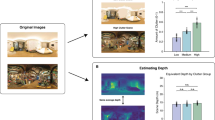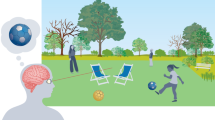Abstract
Attention readily facilitates the detection and discrimination of objects, but it is not known whether it helps to form the vast volume of visual space that contains the objects and where actions are implemented. Conventional wisdom suggests not, given the effortless ease with which we perceive three-dimensional (3D) scenes on opening our eyes. Here, we show evidence to the contrary. In Experiment 1, the observer judged the location of a briefly presented target, placed either on the textured ground or ceiling surface. Judged location was more accurate for a target on the ground, provided that the ground was visible and that the observer directed attention to the lower visual field, not the upper field. This reveals that attention facilitates space perception with reference to the ground. Experiment 2 showed that judged location of a target in mid-air, with both ground and ceiling surfaces present, was more accurate when the observer directed their attention to the lower visual field; this indicates that the attention effect extends to visual space above the ground. These findings underscore the role of attention in anchoring visual orientation in space, which is arguably a primal event that enhances one’s ability to interact with objects and surface layouts within the visual space. The fact that the effect of attention was contingent on the ground being visible suggests that our terrestrial visual system is best served by its ecological niche.
This is a preview of subscription content, access via your institution
Access options
Subscribe to this journal
Receive 12 digital issues and online access to articles
$119.00 per year
only $9.92 per issue
Buy this article
- Purchase on Springer Link
- Instant access to full article PDF
Prices may be subject to local taxes which are calculated during checkout




Similar content being viewed by others
References
Alhazen, I. The Optics of Ibn-Haytham Vol. 1, 1039–1989 (Warburg Institute, 1989).
Gibson, J. J. The Perception of the Visual World (Houghton Mifflin, 1950).
Sedgwick, H. A. in Handbook of Perception and Human Performance (eds Boff, K. R. et al.) 21.1–21.57 (Wiley, 1986).
Sinai, M. J., Ooi, T. L. & He, Z. J. Terrain influences the accurate judgement of distance. Nature 395, 497–500 (1998).
Ooi, T. L., Wu, B. & He, Z. J. Distance determined by the angular declination below the horizon. Nature 414, 197–200 (2001).
Ooi, T. L., Wu, B. & He, Z. J. Perceptual space in the dark affected by the intrinsic bias of the visual system. Perception 35, 605–624 (2006).
Aznar-Casanova, A., Keil, M. S., Moreno, M. & Supèr, H. Differential intrinsic bias of the 3-D perceptual environment and its role in shape constancy. Exp. Brain. Res. 215, 35–43 (2011).
Zhou, L., He, Z. J. & Ooi, T. L. The visual system’s intrinsic bias and knowledge of size mediate perceived size and location in the dark. J. Exp. Psychol. Learn. Mem. Cogn. 39, 1930–1942 (2013).
Wu, J., He, Z. J. & Ooi, T. L. The visual system’s intrinsic bias influences space perception in the impoverished environment. J. Exp. Psychol. Hum. Percept. Perform. 40, 626–638 (2014).
Philbeck, J. W. & Loomis, J. M. Comparison of two indicators of perceived egocentric distance under full-cue and reduced-cue conditions. J. Exp. Psychol. Hum. Percept. Perform. 23, 72–85 (1997).
Posner, M. I. Orienting of attention. Q. J. Exp. Psychol. 32, 3–25 (1980).
He, S., Cavanagh, P. & Intriligator, J. Attentional resolution and the locus of awareness. Nature 383, 334–338 (1996).
McCarley, J. S. & He, Z. J. Asymmetry in 3-D perceptual organization: ground-like surface superior to ceiling-like surface. Percept. Psychophys. 62, 540–549 (2000).
Bian, Z., Braunstein, M. L. & Andersen, G. J. The ground dominance effect in the perception of 3-D layout. Percept. Psychophys. 67, 802–815 (2005).
Wu, J., Zhou, L., Shi, P., He, Z. J. & Ooi, T. L. The visible ground surface as a reference frame for scaling binocular depth of a target in midair. J. Exp. Psychol. Hum. Percept. Perform. 41, 111–126 (2015).
Rieser, J. J., Ashmead, D., Talor, C. & Youngquist, G. Visual perception and the guidance of locomotion without vision to previously seen targets. Perception 19, 675–689 (1990).
Loomis, J. M., Da Silva, J. A., Fujita, N. & Fukusima, S. S. Visual space perception and visually directed action. J. Exp. Psychol. Hum. Percept. Perform. 18, 906–921 (1992).
Loomis, J. M. & Philbeck, J. W. in Embodiment, Ego-space, and Action (eds Klatzky, R. L. et al.) 1–43 (Psychology Press, 2008).
Ooi, T. L. & He, Z. J. Space perception of strabismic observers in the real world environment. Invest. Ophthalmol. Vis. Sci. 56, 1761–1768 (2015).
Meng, J. C. & Sedgwick, H. A. Distance perception mediated through nested contact relations among surfaces. Percept. Psychophys. 63, 1–15 (2001).
Ni, R., Braunstein, M. L. & Andersen, G. J. Scene layout from ground contact, occlusion, and motion parallax. Vis. Cogn. 15, 46–68 (2007).
Chun, M. M. & Wolfe, J. M. in Blackwell Handbook of Sensation and Perception (ed. Goldstein, E. B. ) 272–310 (Blackwell, 2001).
Chun, M. M., Golomb, J. D. & Turk-Browne, N. B. A taxonomy of external and internal attention. Annu. Rev. Psychol. 62, 73–101 (2011).
Treisman, A. & Gelade, G. A feature-integration theory of attention. Cogn. Psychol. 12, 97–136 (1980).
Wu, B., Ooi, T. L. & He, Z. J. Perceiving distance accurately by a directional process of integrating ground information. Nature 428, 73–77 (2004).
Wu, J., He, Z. J. & Ooi, T. L. Perceived relative distance on the ground affected by the selection of depth information. Percept. Psychophys. 70, 707–713 (2008).
Gogel, W. C. & Sharkey, T. J. Measuring attention using induced motion. Perception 18, 303–320 (1989).
Potter, M. C. Meaning in visual search. Science 187, 965–966 (1975).
Greene, M. R. & Oliva, A. Recognition of natural scenes from global properties: seeing the forest without representing the trees. Cogn. Psychol. 58, 137–176 (2009).
Greene, M. R. & Oliva, A. The briefest of glances: the time course of natural scene understanding. Psychol. Sci. 20, 464–472 (2009).
Fei-Fei, L., Iyer, A., Koch, C. & Perona, P. What do we perceive in a glance of a real-world scene? J. Vis. 7, 1–29 (2007).
Greene, M. R. & Wolfe & J. M. Global image properties do not guide visual search. J. Vis. 11, 1–9 (2011).
Qiu, F. T., Sugihara, T. & von der Heydt, R. Figure-ground mechanisms provide structure for selective attention. Nat. Neurosci. 10, 1492–1499 (2007).
Cavanagh, P., Hunt, A., Afraz, A. & Rolfs, M. Visual stability based on remapping of attention pointers. Trends. Cogn. Sci. 14, 147–153 (2010).
Acknowledgements
This study was supported by grants from the National Institutes of Health (EY023374 and EY023561) to T.L.O. and Z.J.H. The funders had no role in study design, data collection and analysis, decision to publish, or preparation of the manuscript.
Author information
Authors and Affiliations
Contributions
L.Z. conducted the experiments, performed the data analysis and wrote the paper. C.D. wrote the software for the experiments and participated in testing observers. Z.J.H. and T.L.O. provided the theoretical motivation, performed the data analysis and wrote the paper.
Corresponding authors
Ethics declarations
Competing interests
The authors declare no competing interests.
Supplementary information
Supplementary information
Control experiment, Supplementary Figure 1. (PDF 189 kb)
Rights and permissions
About this article
Cite this article
Zhou, L., Deng, C., Ooi, T. et al. Attention modulates perception of visual space. Nat Hum Behav 1, 0004 (2017). https://doi.org/10.1038/s41562-016-0004
Received:
Accepted:
Published:
DOI: https://doi.org/10.1038/s41562-016-0004
This article is cited by
-
Backward and forward neck tilt affects perceptual bias when interpreting ambiguous figures
Scientific Reports (2022)
-
Attentional focus modulates automatic finger-tapping movements
Scientific Reports (2021)
-
The foggy effect of egocentric distance in a nonverbal paradigm
Scientific Reports (2021)



